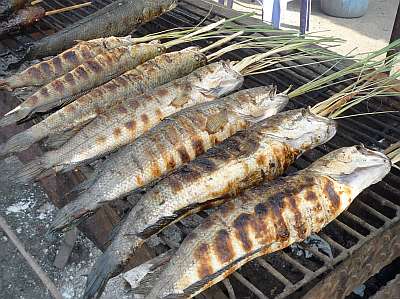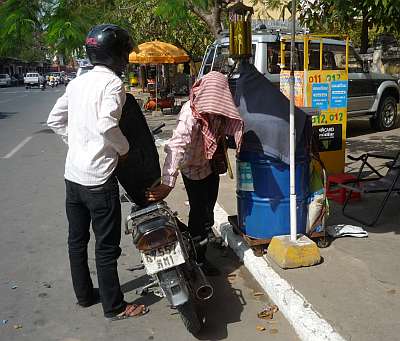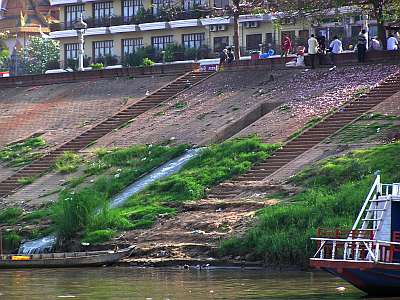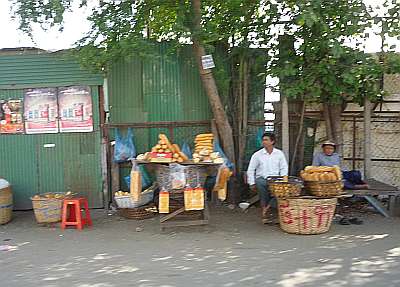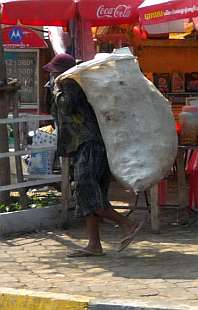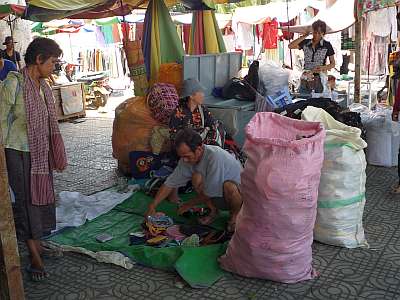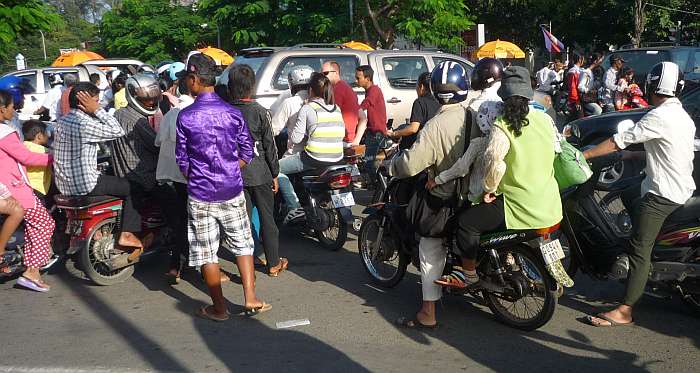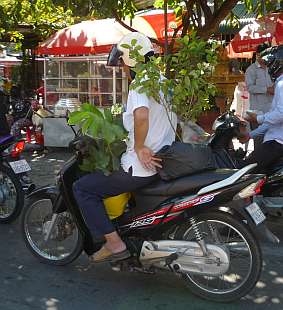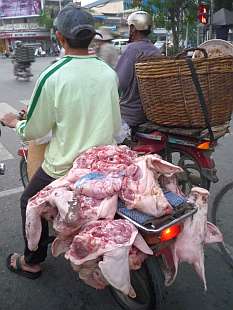|
|
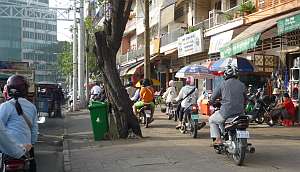 |
When it comes to traffic in Cambodia, there are no rules. Oh, there may be a few on the books, but they are not enforced. There is no expectation of or desire for order in the interaction between vehicles and humans. It really has to be seen to be believed. One example is the way sidewalks are used. Normally they are used for parking and business. The city is designed without any parking space and if there is an empty square meter of sidewalk, someone will take it over and set up some kind of stall selling food or other goods. And if traffic is moving too slow for people, the sidewalks become roads. In this video (11.6 MB), taken with my digital camera, I am experimenting with using video clips on the website. This was taken in the morning while my motorcycle taxi was waiting in traffic for a red light and those on the sidewalk were not. Please let me know if you would find video interesting and useful. |
6 November 2010
In Cambodian culture, very little trash is collected in garbage cans or rubbish bins. The practice is to throw everything on the ground and then come back and sweep it up. A market like this generates literally tons of trash within a few hours. Those responsible for the market think nothing of driving a large frontloader through the crowds to scrape up the trash from the pavement.

This is a morning open-air wholesale market for fruits and vegetables. The picture was taken at 6:00 AM when thousands of people have already been buying and trading and loading for several hours.
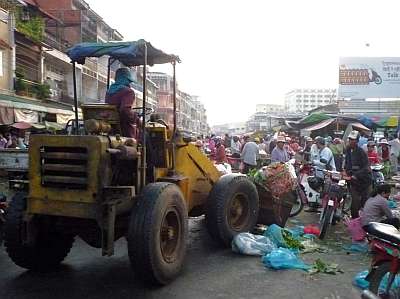
5 November 2010
Don't put all your eggs on one motorcycle 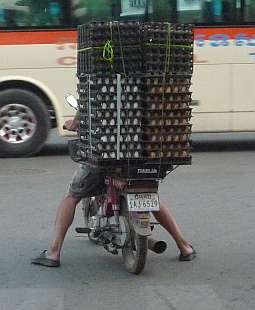
3 November 2010
"I wonder what it's like to be crushed by a quarter ton of asparagus?!" 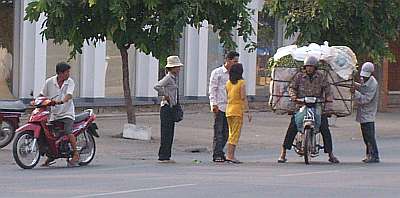
31 October 2010
Last night the temperature went down to 73ºF. I thought it was delightful. I was able to use a sheet for warmth instead of just to keep the mosquitoes off. For the local people, though, it was disaster. They really feel the cold and unusual temperatures like this are COLD for them. I'm sure a lot of people suffered through the night because their houses are not sealed and tight like in colder climes. And this morning there was a rush of buyers for heavy winter coats offered by an enterprising husband and wife who had piles of them on tarps along a well-traveled street, attracting plenty of interested customers.
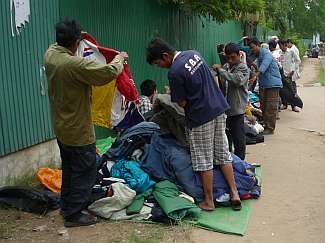
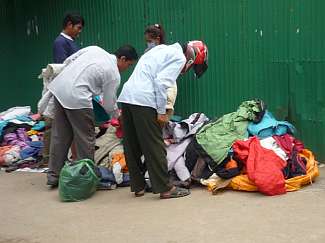
30 October 2010
"I think I prefer a helmet with a visor for keeping the bugs out of my face...." 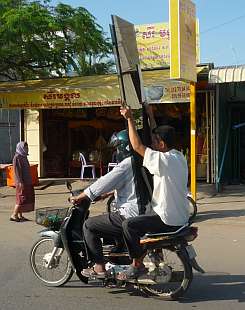
20 September 2010
Everyone has some sort of small business in Cambodia. The families need the additional income so while the father or mother works in a market or some construction job, the other parent opens a food stall in front of the house. 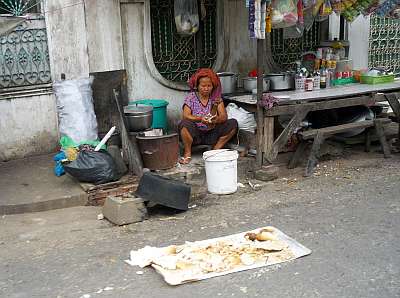
17 September 2010
It's not likely that a sign like this would be placed within reach of pedestrians in most Western countries. Within 24 hours, it would be covered with graffiti and maybe half torn down. There isn't much of a problem with graffiti in Cambodia, but there's a problem with zoning laws and lack of respect for public spaces. The sidewalk is already half blocked by a little "garage" where a man fixes flats and sells gasoline in two-liter Coke bottles. Now the rest of the sidewalk is blocked by the base of the sign. That's not a problem with most Cambodians, however. They are not that far removed from village life and continue to live and walk in the streets--even if there is a clear sidewalk, which there almost never is. 
16 September 2010
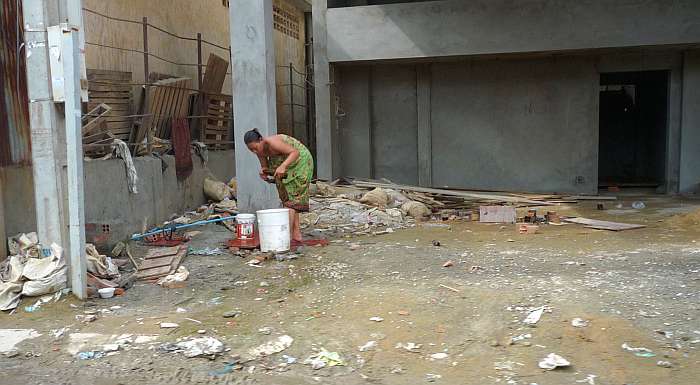
Many poor families, especially those who emigrate from the rural areas to the cities, have no fixed dwelling place, but live on construction sites where they find work as unskilled laborers. This woman is taking a bath and washing clothes on a construction site in Phnom Penh.
14 September 2010
This is another of those oddly worded (in English) signs on the streets of Phnom Penh, and this one, too, is from a car repair place. Your car engine isn't knocking? Bring it in! This shop will knock it for you! 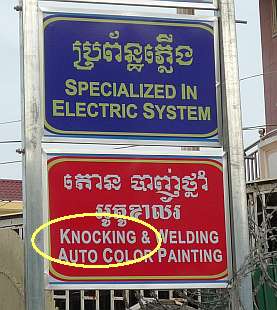
13 September 2010
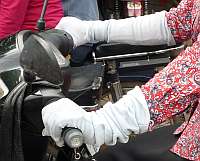 |
Going to great lengths... |
12 September 2010
"...but I don't talk on my telephone when I'm riding. That would be dangerous!" 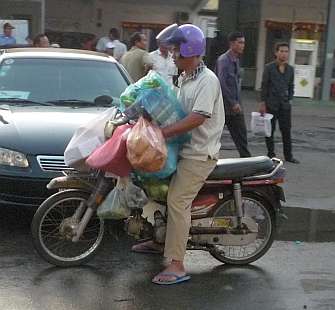
11 September 2010
Sometimes a low-tech approach to advertising gets good results. Here a group of young people attract attention for a new newspaper at a busy intersection during the morning rush hour with a creative visual presence. 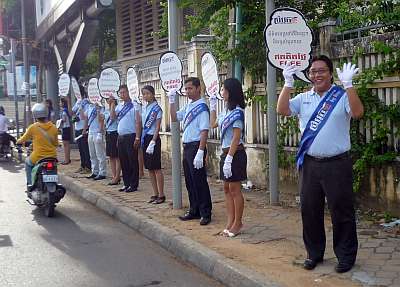
10 September 2010
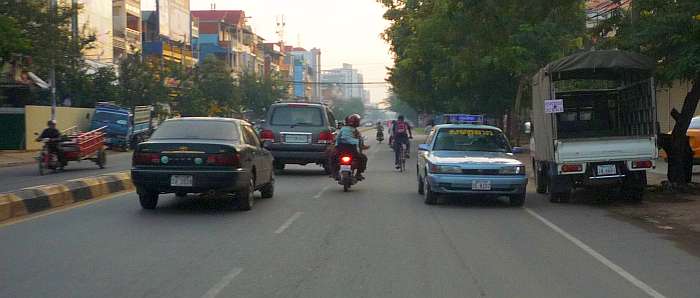
If you want to understand the chaos of driving in Phnom Penh, here is part of the reason for it. Notice the car on the right, going AGAINST traffic on a divided major city street with a barrier erected to prevent exactly that. It's a driver education car from one of the many driving schools in Phnom Penh.
8 September 2010
During a break in a meeting at Catholic Relief Services, I noticed a sprinkler system on top of the roof of the building next door. I found that exceeding odd, first of all since there are no sprinkler systems in Cambodia, and even if there were, why would one put sprinklers on top of the roof instead of under it where it could spray water on a fire? My best guess is that these sprinklers--on the roof of an open veranda in a bar next door--are meant to be some kind of cooling system, spraying water that will evaporate and possibly lower temperatures underneath. 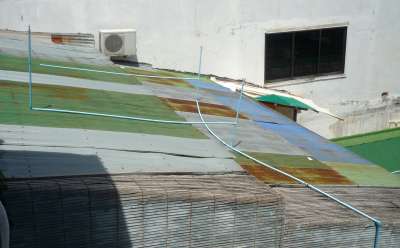
6 September 2010
Every street that has electricity in Phnom Penh has a series of these junction and meter boxes which serve 4 to 8 houses. They contain the meters that Electricite du Cambodge, the local utility company, reads every month and they also contain a circuit breaker, generally the only one for a house since few people put them in their houses because they cost money. These men aren't in the usual EDC uniform but they are probably a company crew checking the service for some house or maybe reading the meters in this neighborhood. The two men travel--with their ladder--on the one motorcycle. 
5 September 2010
Mostly we've shown overloaded motorbikes in Cambodia, but sometimes there ARE some loads they can't balance on a moto, and then they turn to these cyclos, three-wheeled bikes with a bench seat. They are used for hauling big and unwieldy loads not fit for a motorbike (although those are few!). Also a lot of older women use them for shopping and trips to the market when they get past their motorcycle-riding days. Here a cyclo driver heads up Monivong Blvd with a load of shop goods or someone's household possessions. 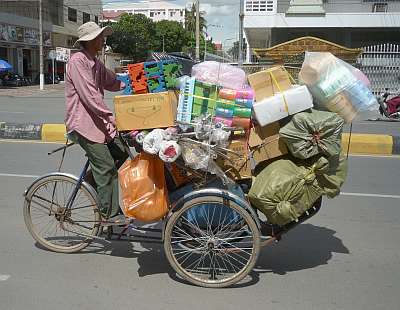
31 August 2010
Phnom Penh's Cintri garbage collection service has some actual garbage trucks that go through various neighborhoods--blowing an air horn to let residents know they are approaching--but many areas are served only by Cintri personnel on foot with pushcarts. Here the garbage collectors converge on a refuse collection point. The one small dumpster on the site is always full so all the garbage is dumped on the ground and then workers use pitchforks to put it into large collection trucks. It's not an efficient--or hygienic--system.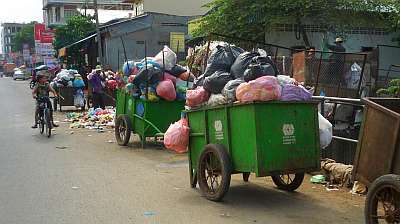
30 August 2010
A few days ago, I mentioned a big hole in the sidewalk created by non-standard sewer openings and coverings that were made on the spot and often cracked and crumbled and disappeared. Well, today I encountered a crew replacing the handcrafted undersized sewer openings on that same neighborhood street that floods regularly--and badly. The workmen were installing pre-fabricated sewer grates into the curb line and breaking up and hauling away the old ones. Whether it will have any effect is another story but it can't hurt to make it easier for the water to get off the street. 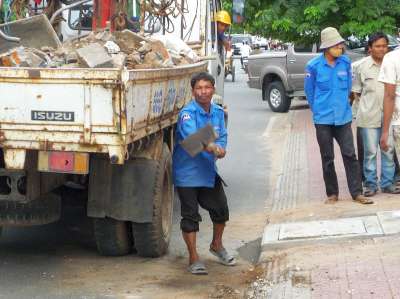
29 August 2010
A really large part of the Cambodian economy is focused on trash and garbage. Many, many people are searching for it, sorting it, carrying it, recycling it, repairing it, selling it. And then what's left gets pitchforked into a dumpster. It's quite a system, dysfunctional but supporting thousands of families. 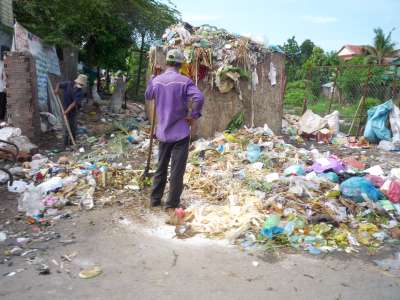
27 August 2010
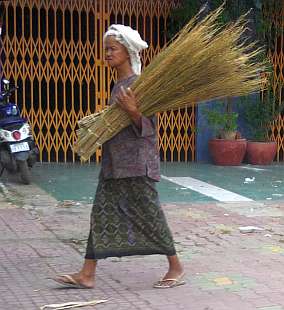
A lot of people are drawn from the provinces to Phnom Penh and other cities by the prospect of jobs or at least something better than the crushing poverty they experience in the rural areas. Most of them have only farming skills. In the city some men become motordupe (motorcycle taxi) drivers. Some women walking the streets selling things. This elderly woman is selling the most basic kind of broom. If she's lucky, she made them herself and can keep all the profit. More likely she buys a bunch from a wholesaler and gets to keep only a few cents for each one sold during a hard day of walking the city streets.
26 August 2010
On the street where the Deaf Development Programme is located, there is a series of squatter shacks erected on the edge of the road. This man and woman, in front of one of the shacks, are preparing vegetables, probably for use in a restaurant. In many eating establishments in developing countries, the food is prepared on the floor or outside in a street or alleyway, where the dishes are washed also, not in running water but in buckets or big pans of water. 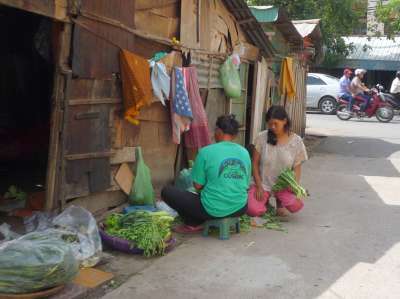
25 August 2010
Sewer openings, manholes, etc., are not standardized in Cambodia. Each such opening is created on location, and the top usually covered with a square concrete lid poured to size at the site. These lids often crumble or otherwise disappear, though, leaving rather deep holes in roadways and sidewalks. They are especially dangerous at night and in the rainy season when the streets flood and the holes are completely covered by water. One street recently displayed an improvised warning signal, to alert people that there is a 3.5-foot deep hole to avoid. 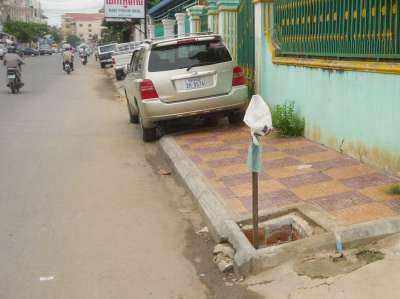
24 August 2010
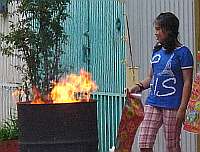 |
Click here to see scenes from the celebration in Phnom Penh of the Chinese Festival of the Hungry Ghosts. |
23 August 2010
The Beefeaters they're not! His posture is a bit casual but then guarding the royal palace out in front is mostly a ceremonial job. 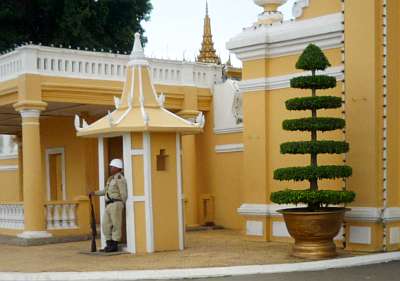
22 August 2010
This is another of the local signs, on a new car repair shop, that is less than clear. What is "body denting"? Maybe they figure that the usual way to dent car bodies--through accidents on the road--is too dangerous. Someone could even get hurt! So now RMT Service will dent your car for you! 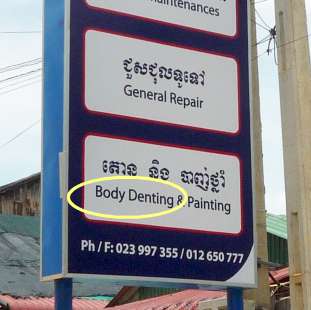
21 August 2010
The Cambodian Red Cross regularly mobilizes their youth members to stand on the corners of major intersections to encourage better traffic law observance. Most often they have red flags which they extend into the street, akin to a railroad crossing gate, to indicate to the motorists that they really should stop at the red light. Other times, as in this picture they stand holding signs exhorting drivers to follow the laws. It's not much but it's more of a positive influence than that given by the traffic police. 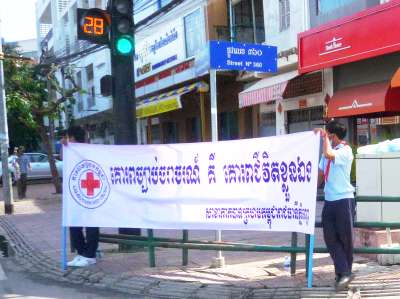
19 August 2010
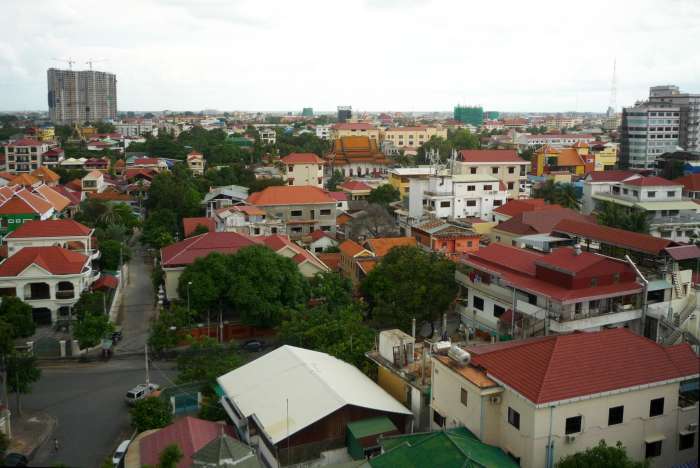
This is the view from an eight-floor window, looking south over Phnom Penh. It's not an impressive skyline but it certainly is different from when I first arrived more than ten years ago. At that time there was one building, a hotel, over four stories high.
17 August 2010
While her husband fashions balustrade columns from huge chunks of luxury wood, the wife cooks lunch amid the construction rubble at a new block of rowhouses. Couples like this--and families--will own no home of their own but live from one building site to the next. 
15 August 2010
The guy in the shop said it's guaranteed to prevent whiplash! 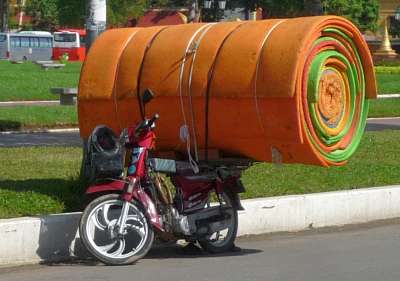
14 August 2010
Something of a landmark on one of the major streets in Phnom Penh is this "banana tree." Every morning a man hangs bunches of bananas from nails pounded into the tree. The tree is set next to the street so it is easy for passers-by to stop and make a purchase. 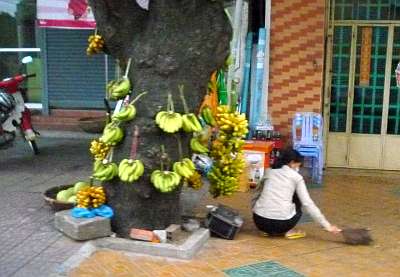
12 August 2010
Many street vendors carry wicker trays of foods or fruits or other items on their heads. But first they have to get to their intended territory, and a motorcycle taxi ("motordupe") is a logical choice if it's not too expensive. This woman covered her goods with a cloth to keep them from blowing away, and then balanced the tray on her head and that of the person in front of her, a classic illustration of the proverb "Two heads are better than one." 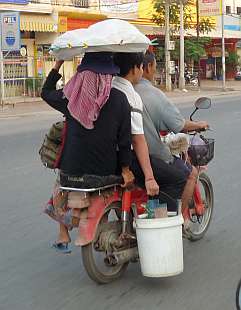
11 August 2010
Another example is the practice of affixing advertising stickers to the front gates and door posts of houses. These vinyl printed stickers--designed to last--promote car rentals, TV repair, taxi services, and just about anything else you can think of. Someone comes along a street and sticks one on every gate on the street--and the residents just think that is wonderful and normal and leave them there! Maybe that ties in with their propensity never to remove labels and stickers on newly purchased goods, no matter how long one may have had the item.  Cambodian people are extremely tolerant of what would be considered extremely outlandish and intrusive behavior in other cultures. Their driving practices are one example. It is totally acceptable, instead of waiting for an opening in traffic, to just pull out in front of another vehicle forcing the other driver to slow down or stop. No one even blows a horn about that.
Cambodian people are extremely tolerant of what would be considered extremely outlandish and intrusive behavior in other cultures. Their driving practices are one example. It is totally acceptable, instead of waiting for an opening in traffic, to just pull out in front of another vehicle forcing the other driver to slow down or stop. No one even blows a horn about that.
8 August 2010
Bugs are very much a part of daily life in Cambodia--mosquitoes, ants, waterbugs, centipedes, roaches, etc.--and normally are not much cause for alarm. The centipedes can give a nasty bite but probably the most problematic bugs, at least in Maryknoll houses which tend to be on the second floor, are the ants. They exist in endless streams over floors and along the walls, and in that there is no problem. But some ants like to inhabit beds and desks and other human-designated furniture, and when that happens, many people use these water barriers to isolate the furniture from the ants which can be both annoying and painful when they bite, particularly when they start their breakfast in bed about 4:00 AM. The blue barriers on the desk in the lefthand photo are made of plastic. The brown barriers on the bed on the right are ceramic. Both designs use a ring of water to prevent ants and other bugs from reaching the legs of the furniture. Both types can be readily found in local markets.
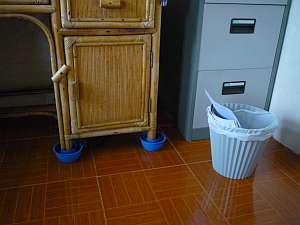
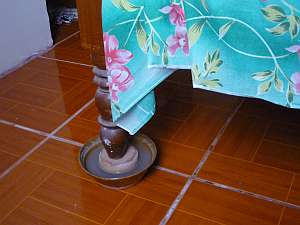
6 August 2010
Two boys eating breakfast on the street at their school in the morning. Many, many Cambodian people eat on the streets rather than at home. One reason is the difficulty of lighting a wood fire for every meal. Then there is no refrigeration to preserve anything. Probably most influential, though, is simply the fact that that is what this culture does. 
Breakfast at School
5 August 2010
Fast food drive-through, Cambodian style. 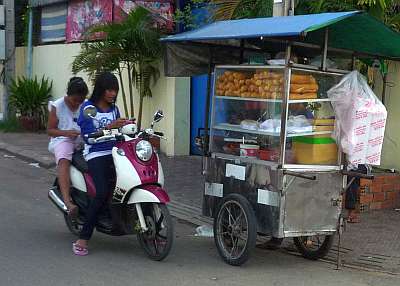
3 August 2010
Here is a gaggle of ducks taking their last ride on a motorcycle. 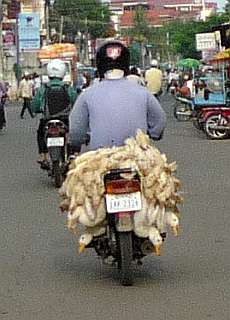
26 June 2010
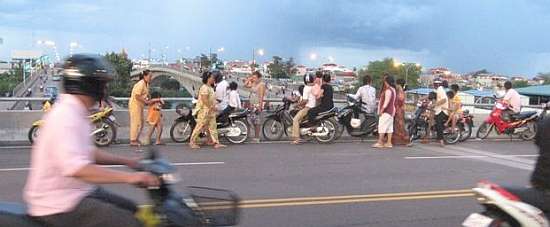
On Friday, 25 June, Cambodia's first overpass (a "flyover" in British English) was inaugurated. It will smooth the passage of traffic over a traffic circle (a "roundabout" in British) that connects two major city streets, the highway to Takeo, the highway to Vietnam, and two bridges across the Bassac River.
An unintended (but not surprising) result of the new overpass is the creation of a new tourist attraction in Phnom Penh. Although there is no shoulder or pedestrian walkway on it, the new overpass has been swarmed by gawkers who ride their motorbikes to the middle, stop to view the traffic below, and take photos of family members. One traffic hazard has been traded for another. The interest in seeing a bird's eye view of traffic is understandable realizing that the large majority of Cambodian people have never even ridden in a car.
[Photo by Jim McLaughlin]
25 June 2010
"The salesman said it's sorta like a full-body helmet, but I been wondering...if I run smack into a cow...." Reflecting on a load of corncobs on a motorcycle. [Photo by Jim McLaughlin] 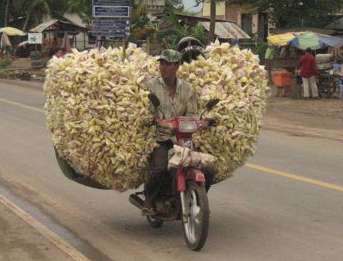
23 June 2010
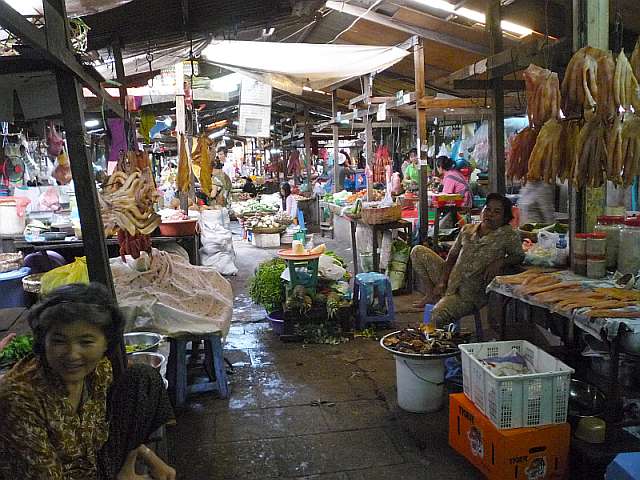
Today I went to the Tuol Tum Pung Market at lunch time, when it is nearly deserted as all the Cambodians head home for a shower, lunch, nap, and changing their clothes. The market has a section for motorcycle parts, clothes, souvenirs for tourists, and this "wet market" for meat and fish and vegetables.
17 June 2010
On a trip to visit families of deaf students in Kampong Cham Province today, this proud mother posed with her little daughter. The little girl has brownish hair, a sign of malnutrition in countries where the population has black hair, and she also has some festering sore on her chest under her chin. 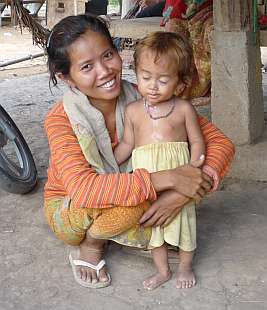
14 June 2010
Continuing on a helmet theme: This little girl got the message about bicycle safety and wearing helmets. What she didn't get--probably couldn't get--is a bicycle helmet. They are relatively hard to find in Cambodia, especially in children's sizes, so this girl is wearing a child-size motorcycle helmet. And it's color coordinated with her bike! 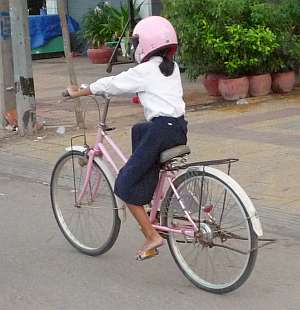
13 June 2010
"...but it's a lot cooler and has a lot more visibility than a regular helmet!" 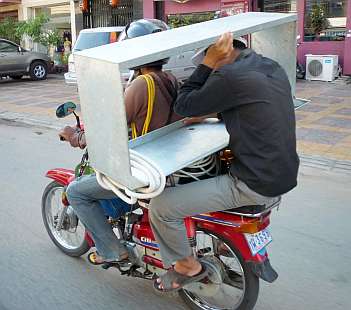
9 June 2010
She doesn't look very comfortable but I suspect the driver is even less comfortable! It's all in an honest day's work, though. 
Motorcycle Passengers and Cargo #136
8 June 2010
When we went to Kampong Som for the priests retreat, we made a detour on the return trip to look at a small farm owned by a former staff of one of the Maryknoll projects. We are interested in finding someone to grow food for the hundreds of children for whom Maryknoll is currently responsible. It was hoped that this farm might be suitable but it lacks water. Life is hard on this dry, dusty patch of land with simple bamboo houses. These two young girls are fixing lunch for the family in the "kitchen" of the house. 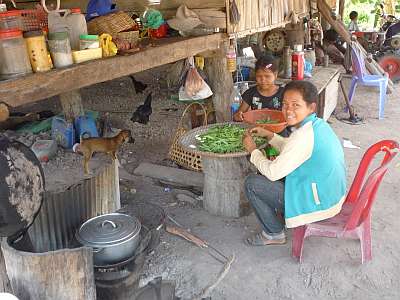
7 June 2010
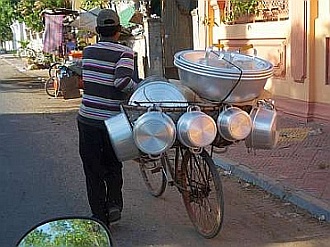

You can find a little bit of everything on Phnom Penh streets, all kinds of vehicles and all kinds of people selling all kinds of products. In an economy with poor transportation, the vendors and goods come to the people. Here are two modern-day tinkers plying their trade on the streets of the capital city.
31 May 2010
"Hey, I'm wearing my helmet!" 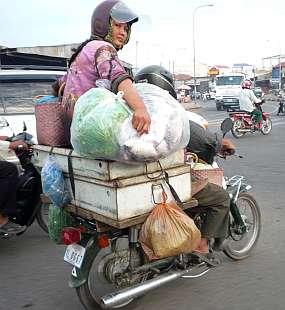
Motorcycle Passengers and Cargo #135
17 May 2010
By dawn's early light 12 hours later, a different group gathers around the mermaid in the traffic circle. This assembly, early morning walkers out for their exercise, are decidedly older and are relying on their feet rather than the motorcycles in the evening. 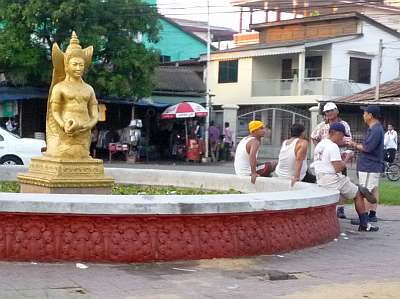
16 May 2010
 As dusk falls in Phnom Penh, young men gather with their motorcycles in a roundabout or traffic circle to chat and hang out. The Phnom Penh roundabouts are marked by various statues--this one of a mermaid--which provide landmarks for giving directions in the city since no one knows the name of streets except the foreigners. Another characteristic of Phnom Penh is evident in the picture--the five-storey house in the background. Land plots here are normally enough to make a building one room wide so many families live in one of these tall narrow structures called a shop house. That is, if they have money. Most families would live in a much simpler wooden house or one floor, or even one room, of one of these shophouses.
As dusk falls in Phnom Penh, young men gather with their motorcycles in a roundabout or traffic circle to chat and hang out. The Phnom Penh roundabouts are marked by various statues--this one of a mermaid--which provide landmarks for giving directions in the city since no one knows the name of streets except the foreigners. Another characteristic of Phnom Penh is evident in the picture--the five-storey house in the background. Land plots here are normally enough to make a building one room wide so many families live in one of these tall narrow structures called a shop house. That is, if they have money. Most families would live in a much simpler wooden house or one floor, or even one room, of one of these shophouses.
15 May 2010
One of the reasons for the chaos on Phnom Penh streets is that there are all types of vehicles, animals, and people mixed together. These ox carts come from Kampong Cham Province where the clay is conducive to making all sorts of pottery implements and vessels. The carts come into the city and wander through the neighborhoods offering their wares to the transplanted province people who still live and cook the same way they did in the provinces.

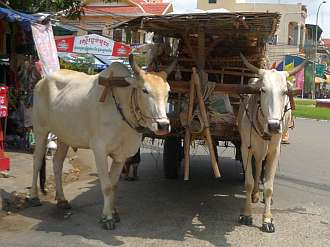
12 May 2010
It is hard to imagine the traffic chaos that exists in Phnom Penh. All of us think we know what traffic congestion is so it is hard to think beyond our own experiences to something of a totally different magnitude. This is a typical intersection at a busy time of day. There is no traffic control and everyone just goes for every space that opens up. It is real anarchy and the government doesn't want to do anything about it. They may not be able to do anything about it because they are so weak and ineffective and are not good at doing things in a logical and ordered way, following set rules.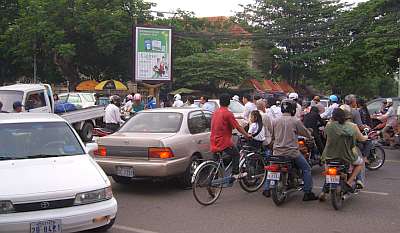
10 May 2010
I had to meet a Maryknoll leader from New York at the Phnom Penh airport and his plane was delayed, not arriving until 11:20 PM. To pass some of the time, I decided to get something to eat, but—as is customary—all the food in the terminal was really pricey, even by Cambodian standards. I had time so I walked 500' out to the street where the ubiquitous food vendors ply their trade. From the young man on the left, I bought an ear of sweet corn (delicious hot, even with no salt or butter on it), and from the woman on the right I got a Coke. The total was $1.50 as opposed to $4 to $5 inside. These vendors have their carts connected to motorcycles and can go wherever the crowds are.
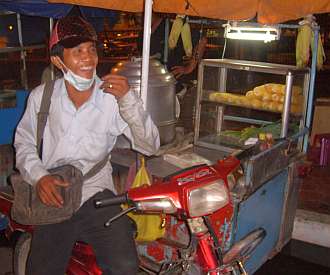
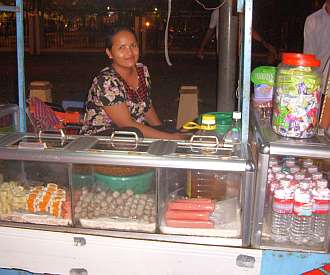
8 May 2010
You have seen pictures of those huge loads on the back of motorcycles in Phnom Penh. Here is how they hold them on—bungee cords made of old inner tubes with a wire hook tied on to each end. 
Motorcycle Passengers and Cargo #133
7 May 2010
This is a parking lot in a Phnom Penh high school. Not one car but lots and lots of motorcycles. And in another lot are plenty of bicycles. Each in-and-out from this parking lot costs the equivalent of seven cents. 
26 April 2010
Most of the people who die in Cambodia are cremated within 24 hours or so, but many of the families of Chinese ancestry prefer burial. They have their own funeral customs and practices, and one of them is using this ornate hearse to transport the body to the burial site from the family home where the monks led prayers. The monks sit on the stools and accompany the body to the place of burial. 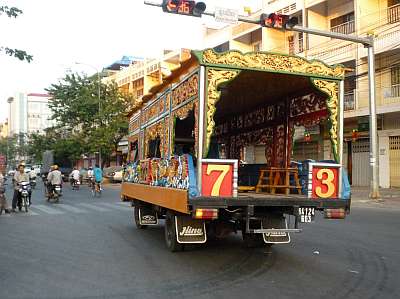
9 April 2010
"I wonder if I can get between that bicycle and the motorcycle?!" 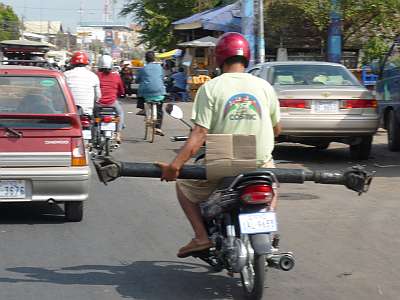
Motorcycle Passengers and Cargo #132
31 March 2010
30 March 2010
26 March 2010
Buddhas, apsaras, garudas, King Jayavaraman, and various figures from Khmer mythology all appear in this display of statuettes on sale at the Russian Market, the favored shopping place for tourists looking for souvenirs and gifts for people back home. Statues are a bit heavy if you're close to your airline weight allowance, but if you've got the space, they're definitely unique gifts from Cambodia!
24 March 2010
23 March 2010
21 March 2010
Today the temperature was in the low 90ºs F (33º C). This young woman displayed a common Cambodian fashion, though—a rather heavy, lined jacket. The intent is keep the wearer out of the sun so her skin doesn't darken, but more often than not, to accomplish that, young women wear what would be cool-weather jackets and coats in colder climes. They are so accustomed to hot weather that wearing a heavy jacket doesn't bother them.
17 March 2010
This the fourth of four photos showing different types of food being carried on motorcycles. Here is a picture of meat being transported. A slaughtered pig is splayed across the back of a motorcycle making its way probably to some meat shop or market stall. The bag might contain some of the innards taken out of the pig and valuable for sale?
14 March 2010
This series was interrupted by the trip to Sri Lanka, but this is photo number three of motorcycles hauling vegetables, fruits, poultry, and meat. Here a load of chickens are taking their first and last ride on a motorcycle, to a market. I've noticed chickens drool a lot when carried this way. It's probably not a very pleasant experience for them.
15 February 2010
This is the second of four photos of motorcycles carrying four basic food groups here in Phnom Penh. The second basic group of foods is the fruits. Bananas--many kinds, shapes, colors, and tastes of them--grow all over Cambodia throughout all the year so they are rather common, and are probably an important part of the diet of poorer people.
14 February 2010
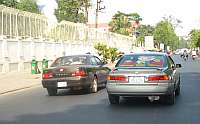
Click here to see photos about driving in the wrong lane in Cambodia. MUCH more to follow!

Click here to see this first set of photos about driving practices in Cambodia. MUCH more to follow!
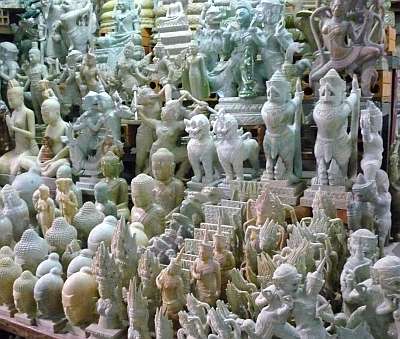

A constant frustration to many foreigners in Cambodia is the local preoccupation with light-colored skin. Light is good; dark is bad. As in so many other areas of consumer products, what comes from the West seems best. Women routinely cover up exposed skin to protect it from the darkening rays of the sun but at the same time they also embrace all sorts of skin lighteners. This model is certainly not Khmer but her face and skin color set an ideal for young girls in Cambodia.
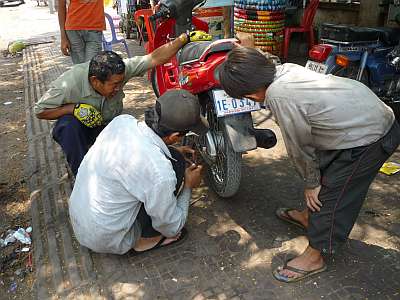
Sunday on the way back from mass, my motorcycle taxi started making a grinding noise and we pulled over. Something was obviously wrong with the chain but there was a little sidewalk repair shop fifteen feet ahead so we pushed the bike over there, the young man who was repairing another bike dropped that project, came over with his tools, took off the chain guard, and found a boogey gear that had sheared a pin or its fastener and was bouncing around on top of the chain. He put a new fastener on and in literally four to five minutes, we were on our way. Here the repairman and his young assistant take off the chain guard.
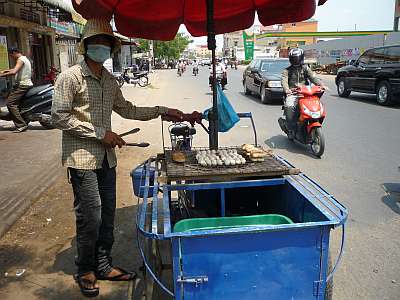
We broke down on the other side of this cart selling roasted plantains and just had to push the 110cc motorbike to this side of the cart. There are guys fixing flats, selling gas in Coke bottles, etc., every few hundred feet. My driver paid 2000 riel (50¢) for this repair. That's the part of Phnom Penh I like.
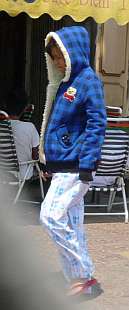
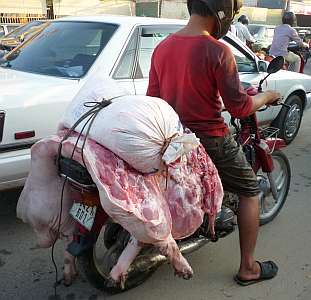
Motorcycle Passengers and Cargo #131
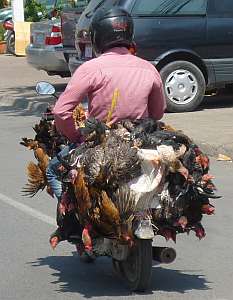
Motorcycle Passengers and Cargo #130
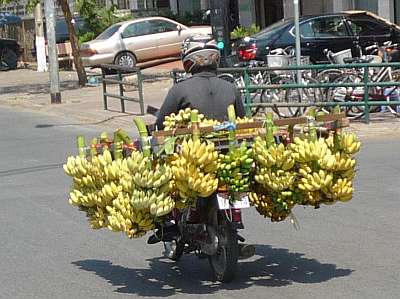
Motorcycle Passengers and Cargo #129
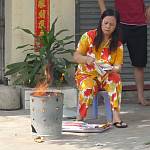
| Click here to see pictures of preparation for the Year of the Tiger |
13 February 2010
The next four photos of motorcycle loads will illustrate how the four basic food groups are treated and transported on motorcycles here in Phnom Penh. The first basic food group to be featured is the vegetable group. Here a young man hauls a load of tofu and bean sprouts, the essentials for a basic vegetarian meal. It doesn't show in the photo, but the tofu is actually steaming hot. Not very hygienic but probably rather nutritious. 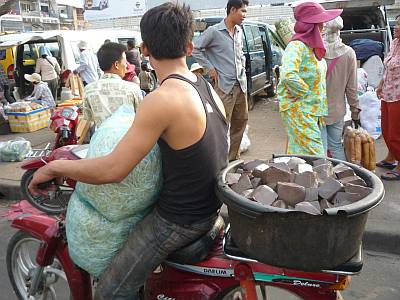
Motorcycle Passengers and Cargo #128
6 February 2010
It is not unusual to see elderly people alone on the streets of Phnom Penh, often just sitting on the sidewalk like this woman. Is she resting? Is she abandoned or cast out? Is she homeless? Ill? Some elderly couples have obviously come in from the provinces and have nothing. Others, like this lady...who knows? 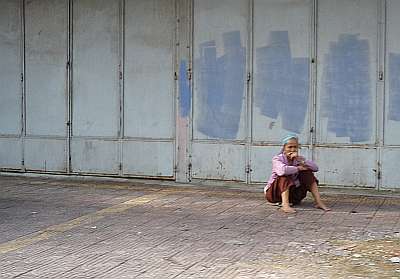
3 February 2010
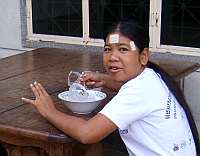 |
Click here to see pictures of a traditional herbal health practice. |
3 February 2010
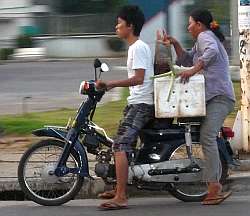 |
Click here to see pictures of some of the most uncomfortable motorcycle rides in Phnom Penh. But, hey, we're earning some money! |
31 January 2010

Nowhere near all the motorcycle riders are wearing helmets here and even fewer bicyclists. These four young people are all wearing the same model motorcycle helmet which suggests that they may all belong to the same organization that gave out helmets for free. Given that today is a Sunday, they may be coming or going to some Christian church service.
13 January 2010
"It's sorta like a float in the Macy's parade, doncha think?" 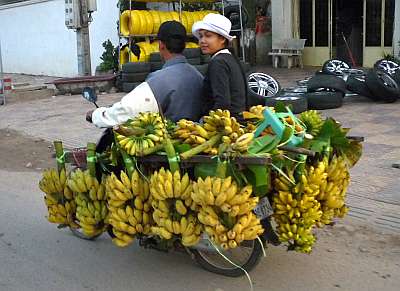
Motorcycle Passengers and Cargo #127
8 January 2010
The most popular kind of bicycle basket here--almost all bikes have them--has a utilitarian shape and size, but they are made out of plastic, with slatted sides. Once the little slats start to go, the basket rapidly deteriorates. My basket had reached the non-functioning stage and I was also having problems with my gear-changing derailleur so a couple days ago—on New Year's Day actually—I pedaled over to the row of bike shops near the Capitol Guest House. I found a family of four--mother, father, and two teenage sons--who hopped right on my repair work and had it finished in thirty minutes or so. I asked for an extra big basket made of metal and they found an old second-hand one in the back of the shop and put it on, and then the father--definitely the repository of experience in the family—-started adjusting the gears. I paid them $3.75 and took off! 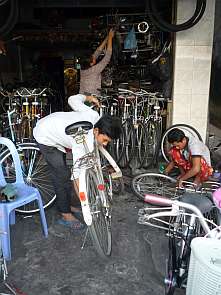
4 January 2010
The gap between the wealthy and the poor is tremendous in Cambodia, and for those who have, it's nothing to hide. Consider this family dwelling being built in Phnom Penh. It couldn't be much more over the top. Every inch says: "I have it. You don't." 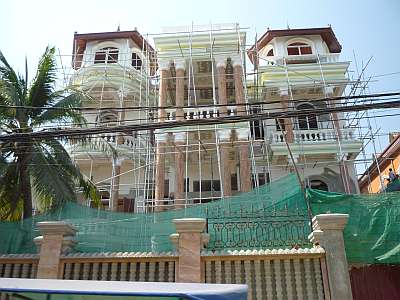
1 January 2010
You can get fast-food fish sandwich at McDonald's or other fast-food outlets in the developed world. Here in Cambodia you get the whole fish, freshly grilled. 